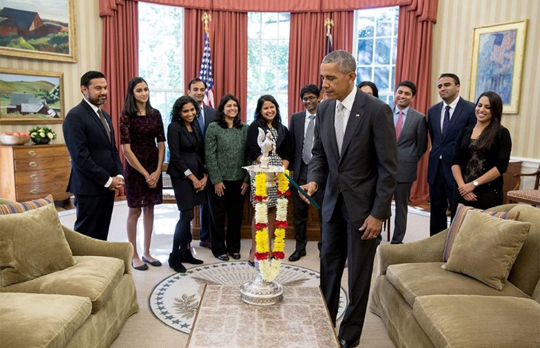Washington, Oct 31: US President Barack Obama has celebrated Diwali by lighting the first-ever diya in the Oval Office of the White House and hoped that his successors would continue the tradition.

Obama, who was the first president to celebrate Diwali personally at the White House in 2009, talked about this momentous occasion in a Facebook post soon after he kindled the diya in his Oval Office with some Indian-Americans working in his administration.
"I was proud to be the first President to host a Diwali celebration at the White House in 2009, and Michelle and I will never forget how the people of India welcomed us with open arms and hearts and danced with us in Mumbai on Diwali," Obama said.
"This year, I was honoured to kindle the first-ever diya in the Oval Office -- a lamp that symbolises how darkness will always be overcome by light. It is a tradition that I hope future Presidents will continue," Obama said on the White House Facebook page, which became viral on the social media.
By late night it was liked by more than 1.5 lakh people and shared more than 33,000 times.
"On behalf of the entire Obama family, I wish you and your loved ones peace and happiness on this Diwali," Obama said.
"To all who are celebrating the festival of lights across America and around the world, happy Diwali. As Hindus, Jains, Sikhs, and Buddhists light the diya, share in prayers, decorate their homes, and open their doors to host and feast with loved ones, we recognise that this holiday rejoices in the triumph of good over evil and knowledge over ignorance," said the US President.
"It also speaks to a broader truth about our shared American experience. It's a reminder of what's possible when we see beyond the differences that too often divide us. It's a reflection of the hopes and dreams that bind us together," he said.
Obama said that it is a time to renew collective obligation to deepen those bonds, to stand in each other's shoes and see the world through each other's eyes, and to embrace each other as brothers and sisters -- and as fellow Americans.
Democratic presidential candidate Hillary Clinton, who has a large fan following in the Indian-American community greeted Hindus, Sikhs, Buddhists and Jains across the world on the occasion of Diwali.
"On Sunday, nearly a billion Hindus, Jains, Sikhs, and Buddhists around the world -- including more than two million Americans -- will celebrate Diwali, the festival of lights. For members of these faiths, lighting the lamp (the diya) is a reminder that light prevails over darkness, knowledge over ignorance, and good over evil," Clinton said.
"Here in the United States, it is a tribute to the Indian American community that Diwali is celebrated with such beauty and joy. Regardless of our personal faith, Diwali reminds us that diversity is one of our greatest strengths as a nation, that light prevails over darkness, and that dharma -- righteousness or goodness -- must guide us toward a better tomorrow," Clinton said.
"If I have the honour of serving as president, I will be committed to building an Administration that reflects such diversity, including continuing White House celebrations of Diwali," she said.
"To those of you celebrating this joyous occasion, I wish you and your loved ones a Happy Diwali and Saal Mubarak," Clinton said in a statement.
There was no such statement from her Republican rival Donald Trump. Her daughter-in-law, Lara Trump had celebrated Diwali at a Hindu temple in Virginia last week.
In a joint statement, the Republican National Committee (RNC) chairman Reince Priebus and co-chair Sharon Day said as Republicans, they continue to support religious freedom across the country, so that all Americans can continue to share these great traditions with the communities.
"Diwali marks a special time as our friends and neighbors of Hindu, Jain and Sikh faiths celebrate this year's Festival of Lights," said Chairman Priebus.
"During this celebration, we are not only reminded of the traditions that many immigrants bring that make our country more strong and more diverse, but also of the many blessings we have in our daily lives.
"From the music to the feasts, to the remembrance of Bandi Chhor Divas, a Sikh festival celebrating emancipation from religious persecution, Diwali also serves as a time for families to contemplate the past year, and what they look forward to in the future," the joint statement said.





Comments
Add new comment